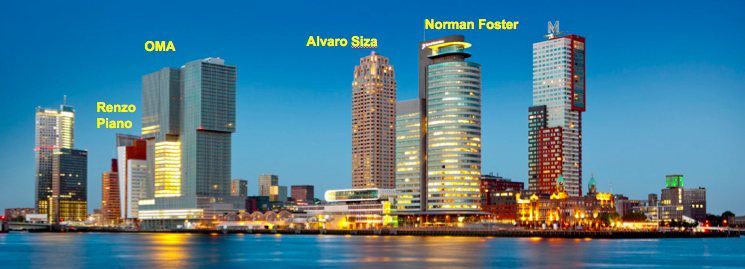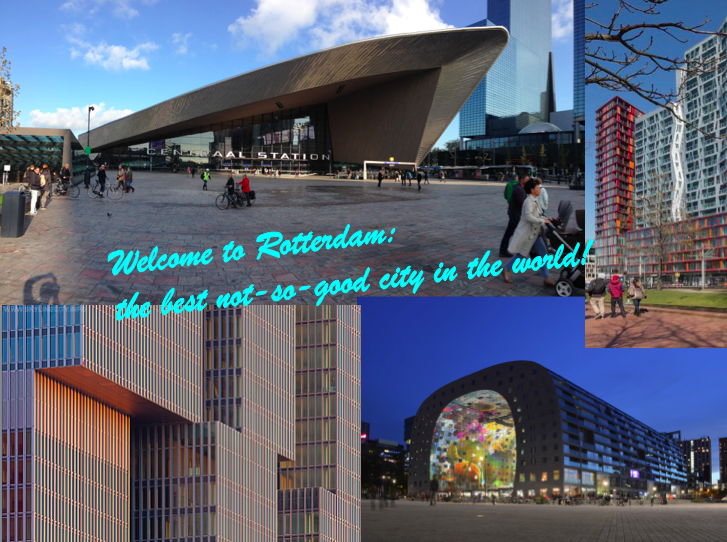Story
Rotterdam in the 20th century has been through wrenching changes, some forced, but most voluntary…
 Before the Second World War, Rotterdam was a typical Dutch city, dense, with what we would call today a “fine grain”.
Before the Second World War, Rotterdam was a typical Dutch city, dense, with what we would call today a “fine grain”.
The bombardment by the Nazis in 1940 erased the city center – only 12 buildings survived – creating a kind of eternal tabula rasa on which experiments will be constantly played out over the next decades.
 Rotterdam built the first pedestrianized shopping street, a strategy that proposed to separate the city’s core components – traffic, commerce, living.
Rotterdam built the first pedestrianized shopping street, a strategy that proposed to separate the city’s core components – traffic, commerce, living.
 Successive generations of architects were granted freedom of the city, creating a laboratory that became the ultimate postmodern melange, with Oude Haven its focal point (#nofilter): early skyscraper, sailboats, socialist housing, structuralist cube forest, HiTech echoes, fine-grain sprawl…
Successive generations of architects were granted freedom of the city, creating a laboratory that became the ultimate postmodern melange, with Oude Haven its focal point (#nofilter): early skyscraper, sailboats, socialist housing, structuralist cube forest, HiTech echoes, fine-grain sprawl…
 Rotterdam cultivated a faith in icons as a means of building urban substance, which create an impressive skyline only.
Rotterdam cultivated a faith in icons as a means of building urban substance, which create an impressive skyline only.
 Rotterdam struggles to conjure living substance out of its architectural magic dust. Next to Marcel Brauer’s monumental block of a Bijenkorf building (left), a more recent shopping experiment, with the desultory name “Koopgoot” (literally, shopping gutter), remains empty after shopping hours…
Rotterdam struggles to conjure living substance out of its architectural magic dust. Next to Marcel Brauer’s monumental block of a Bijenkorf building (left), a more recent shopping experiment, with the desultory name “Koopgoot” (literally, shopping gutter), remains empty after shopping hours…
 A recent municipal report lays out a strategy for the activation of the Rotterdam’s core. Previous areas of developmental focus (2-13) are being shelved, with only the core – number 1 – remaining. The document emphasizes an increased density and startups, the creative industry, and the need to attract “rootless” young people, who must be allowed to remain rootless. But there is a disjunction between this development strategy of centralisation and the reality of the city, in which all the ‘desired’ activities take place on the periphery.
A recent municipal report lays out a strategy for the activation of the Rotterdam’s core. Previous areas of developmental focus (2-13) are being shelved, with only the core – number 1 – remaining. The document emphasizes an increased density and startups, the creative industry, and the need to attract “rootless” young people, who must be allowed to remain rootless. But there is a disjunction between this development strategy of centralisation and the reality of the city, in which all the ‘desired’ activities take place on the periphery.
 The faith in icons endures. Several have been completed in the past couple of years, a new train station, so large it seems to anticipate a day when Rotterdam becomes a city of 5 million (current population: 610,386), together with an enormous markethall arched by apartments, the Netherlands’ largest building, and jaunty housing developments within the core. The city is really trying, and it’s impressive, but a sense of emptiness lingers, a perpetual frustrated expectation.
The faith in icons endures. Several have been completed in the past couple of years, a new train station, so large it seems to anticipate a day when Rotterdam becomes a city of 5 million (current population: 610,386), together with an enormous markethall arched by apartments, the Netherlands’ largest building, and jaunty housing developments within the core. The city is really trying, and it’s impressive, but a sense of emptiness lingers, a perpetual frustrated expectation.
The payoff, for the municipality anyway, seems to be arriving nevertheless. Rotterdam is assuming its place on coveted lists of top cities. Years after its port migrated towards the coast and passenger travel evaporated, Rotterdam is becoming a destination city again.
 Rotterdam has a plethora of institutions, think tanks, architectural offices and universities monitoring the situation, ready to usher in more change, as if one more design might finally crack the problem.
Rotterdam has a plethora of institutions, think tanks, architectural offices and universities monitoring the situation, ready to usher in more change, as if one more design might finally crack the problem.
But maybe Rotterdam’s the emptiness forced on bombardment is an inescapable condition, a new default: the hollow-core, the new normal…



